| Industrial Narrow Gauge Railways
|
The Springfield Agricultural Railway
|
(click on photos to enlarge, use browser back button to return)
Updates and News
Winter 2012 Update:
A few updates from summer and winter 2012. Although the ground has been very waterlogged due the extreme levels of rainfall ths winter, the railway has continued to be used typically at least once per weekend.
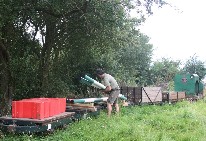
|
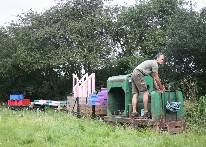
|
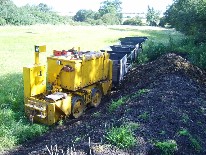
|
|
Date: August 2012
|
Date: August 2012
|
Date: July 2012
|
|
A collection of horse jumps have been built up over the last few years, and from time to time these are moved to different fields depending on the time of year.
|
The railway is the most conveient method of moving these bulky items, with a mix of open wagons and flat wagons.
|
In July the W&R loco was on muck duties with both open wagons and skips in use.
|

|
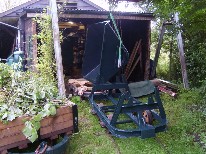
|
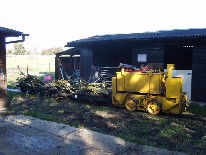
|
|
Date: June 2012
|
Date: July 2012
|
Date: October 2012
|
|
the last German skip was given the standard facelift, and after a good clean with the wire brush and angle grinder, it was treated with rust converter and body filler before painting.
|
After another couple of weeks it was ready to be put back together so the hoist was used to drop the bucket back onto the frame.
|
Two to three times a year there is a collection of timber from around the perimeter of the fields, and this is taken back to the timber pile for cutting and splitting. It helps to keep the wood burner in busy.
|
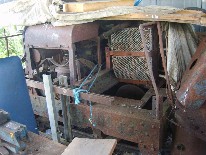
|
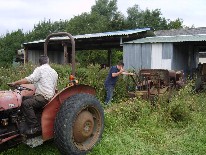
|
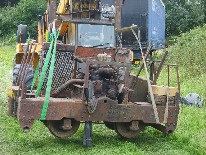
|
|
Date: September 2012
|
Date: September 2012
|
Date: September 2012
|
|
A Motor Rail had been stored in an open barn in a village south of Cambridge, along with a collection of other narrow gauge items in an adjacent field.
|
The cabless 20/28hp Motor Rail was seen as another ideal loco for the railway, but after protracted negotiations the whole collection had to be purchased to obtain the loco. A tractor provided assistance to haul the loco out into the open for the first time in approx 8 years.
|
Big boys toys like this Loadall are always useful to provide help when trying to move heavy lumps of metal around.
|

|
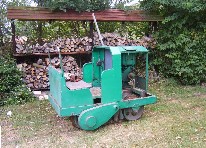
|

|
|
Date: September 2012
|
Date: September 2012
|
Date: December 2012
|
|
2ft gauge track panels were also part of the collection obtained, and with a low loader and fork lift, all the items were moved back to Springfield.
|
Stored alongside the Motor Rail there was also a converted Wickham Target Trolley which was also moved to it's new home at the same time.
|
It had been rebuilt with a single cylinder Lister engine instead of the original JAP engine. However, the Wickham was surplus to needs and was sold on to recoup some of the costs involved, and left site on the 7th of December 2012.
|
Spring 2012 Update:
The railway has continued to operate throughout the winter, with the exception of a couple of short spells of snow. Because the rails are at ground level, even a small amount of snow causes problems. At the start of April the older manure has been dug out into skips and is being distributed as usual. It's not surprising all our neighbours have great roses!

|
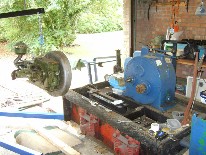
|

|
|
Date: May 2011
|
Date: October 2011
|
Date: October 2011
|
|
A few months after delivery by the Leemspoor Museum in Holland, the Spoorijzer loco was moved into the workshop.
|
As the loco has been gradually taken apart, unfortunately it is not in the 'runnable' condition suggested by the Leemspoor Museum. The Farymann engine was not in running order, and the fuel pump is being worked on, and the gearbox had been emptied of oil and rusted up.
|
Also the brake gear appeared to be a combination of parts from other locos, and has required a bit of work to reinstate. All in all not the swap of 'working' locos that was wanted. It will still be a while before this loco is back in working order.
|
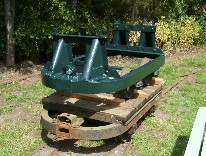
|
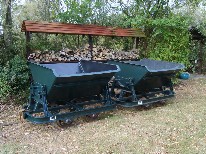
|
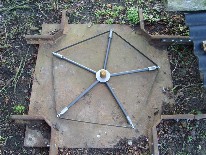
|
|
Date: June 2011
|
Date: October 2011
|
Date: January 2012
|
|
One by one the wagons are being gradually renovated and repainted, and here the small Huson skip has just had the final coat of paint.
|
By October 2011, a second of the East German skips had been restored. Although the skip buckets have some corrosion, there should be a good few years of life in them now.
|
Although a wagon turntable was obtained, there was no revolving 'spider' present under the top plate. Over a period of several months one has been fabricated with bearings machined at the end of 5 'arms', seen here with the top plate removed.
|
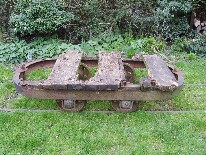
|
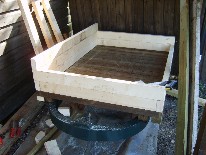
|
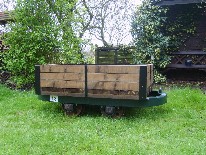
|
|
Date: March 2011
|
Date: January 2012
|
Date: April 2012
|
|
An old Hudson flat wagon had been obtained over a year ago, potentially just to rescue the wheels and axleboxes. On closer inspection the frame was in useable condition, and a further wagon planned.
|
After taking it apart, de-rusting and painting, a timber platfrom was built, and 2x4 timber used to construct a solid low sided open wagon.
|
Once the steel angle and supports were bolted on, it was finally completed by April 2012.
|

|
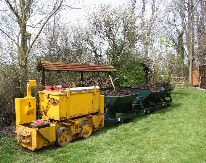
|
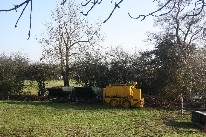
|
|
Date: August 2011
|
Date: April 2012
|
Date: February 2012
|
|
The yearly service for the W&R battery loco was carried out over summer, and apart from brake blocks starting wear a little thin, it's a big relief that this loco is a reliable performer.
|
In the second week of April last year's manure was being dug out to transport down onto the driveway for local distribution.
|
A few months before, the W&R was in use, dumping another 2 skips of muck onto the ever increasing stockpile.
|
Summer 2011:
Summer seemed to start around March this year and East Anglia in particular suffered near drought conditions right the way through to the end of June, and still has not had the levels of rainfall expected for this time of year.
The very dry conditions early in the year allowed a lot of work to be done outside, with additonal sheds built and other shelters moved, and trackwork realigned and several new sets of points installed.
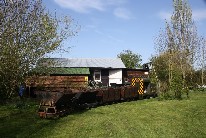
|
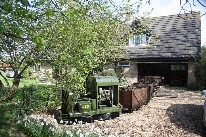
|
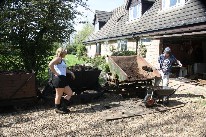
|
|
Date: April 2011
|
Date: April 2011
|
Date: April 2011
|
|
The yearly dig out of the manure compost took place in April, and approx 8-10 skips of manure were dug out over several weekends providing loads of up to 4 wagons.
|
This year, as the tracks had been laid down to the drivway the wagons were moved to the driveway making it easier for people to come and load up with compost.
|
Digging the compost out of the skips and into wheelbarrows can be just as hard as loading up in the first place. As last year, quite a few neighbours turned out to take advantage of the free manure and to assist, our local farmer even loaded up a large JCB bucket to transport down the road to others a little further away.
|
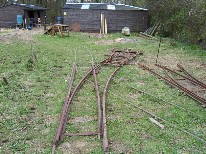
|

|
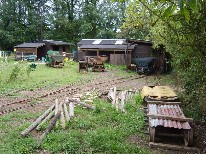
|
|
Date: April 2011
|
Date: April 2011
|
Date: May 2011
|
|
Once all the manure had been dug out for the year, planned major changes in the track layout could take place. 3 points were obtained to provide more siding space and they were roughly positioned like a giant jigsaw to work out the options.
|
The first action was to sever the main line by digging out the old point to the stock shed and digging in extra sleepers to support the new point. As the first new point was essentially a kit of parts, it took a lot of tinkering (a technical phrase!) to finally get the gauge correct all round.
|
Another shelter for the stock was built, and the original stock shed was moved, so once the rest of the new layout was in place, it allows a little more organisation, and keeps more of the stock dry and under cover. with a bit of luck that will be all the tracklaying required for a while now.
|
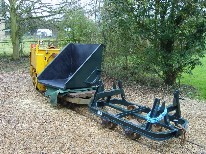
|
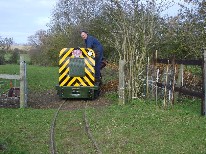
|
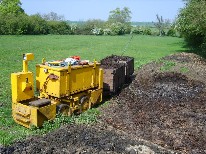
|
|
Date: February 2011
|
Date: April 2011
|
Date: May 2011
|
|
Over the winter one of the East German skips was sanded down and repainted, hopefully extending its working life in the process. Seen here with all the painting completed and being pulled to the 'A' Frame so the skip body can be lifted back into position.
|
Although the battery loco takes the brunt of the hard work, the MoŽs locos need to be run regularly to keep them in good working order. No.10 here is seen coming back from the muck heap with a load of dug manure.
|
The W&R loco waiting to return from the muck heap in May 2011.
|
Winter 2010:
Winter is always the busiest time for the railway, with the horses coming into the stables overnight, so from the start of November onwards the skips are in use daily. It usually requires at least one trip with 2 or 3 skips every weekend for tipping. Assistance has been needed with moving hay and feed as well. Things have been progressing on the loco and rolling stock front over the last few months also.
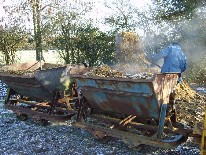
|

|
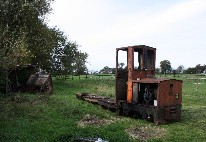
|
|
Date: November 2010
|
Date: November 2010
|
Date: October 2010
|
|
When the skips have been waiting to be tipped for several days, then the heat of the slowly fermenting manure is quite impressive, especially on a chilly day.
|
When feed and hay is delivered, it is now left in the driveway for the railway to move. In the winter the farm track to the fields can become too muddy for the delivey lorry, so it's another little job for the locos.
|
The Alan Keef loco went for several test runs on the line while it was here, but in the end the final decision was that it was not right for the railway.
|
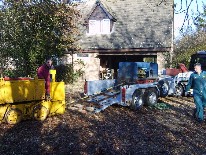
|
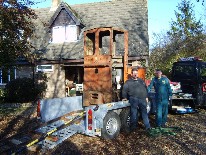
|
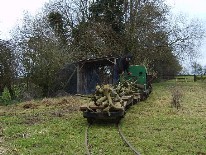
|
|
Date: January 2011
|
Date: January 2011
|
Date: January 2011
|
|
In January representatives from the Leemspoor Narrow Gauge Museum in the Netherlands arrived with a Spoorijzer loco, which was offloaded with the help of the W&R battery loco.
|
For the return trip back to the Netherlands the Alan Keef loco was loaded up, not without a couple of anxious moments as it was winched up the ramp. It was then secured for the journey back.
|
After another tree was partly brought down by high winds last year, it has been slowly dismembered by chainsaw and brought back on the railway.
|
Summer 2010:
A busy summer with a number of major activities, with changes on the loco front, and a lot of work carried out to lay a branch into the workshop (garage).
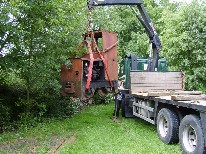
|
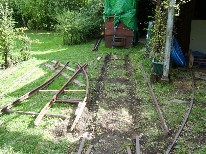
|
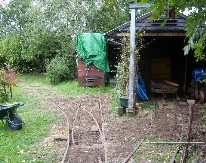
|
|
Date: June 2009
|
Date: August 2009
|
Date: August 2009
|
|
In June the Alan Keef loco, No.9, was delivered and was offloaded using a hi-ab crane.
|
A point for the branch to the workshops was finally obtained as a kit of parts in August, and so the length of track was removed as the first step to bedding the point in.
|
By the end of September the point had been installed and the last few lengths of track laid to connect up the workshop.
|
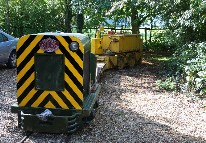
|
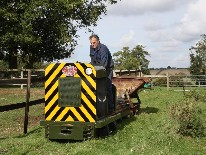
|
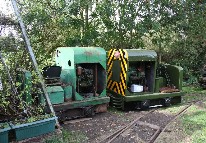
|
|
Date: September 2010
|
Date: September 2010
|
Date: September 2010
|
|
The battery loco and a couple of flats were used to pull No.10 out of the workshop. A couple of lengths of connecting rail at a sharp gradient made for some interesting moments as it came down the slope.
|
So by the end of September No.10 was taken out for the first run to the end of the line.
|
No.12 and No.10 were reunited again after 3 years apart. The difference between these two working locos is clear to see.
|
Spring 2010
Finally after dumping all the horse manure onto the muck heap for over 2 years, it was finally time to dig out the oldest part this spring. With a big effort made to finish No.10, to build a lean-to for the loco shed to incease the undercover space, plus take a spur from the garage to the loco shed to allow stock to move in and out, it has been a busy time.
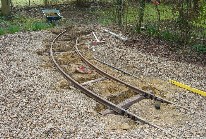
|
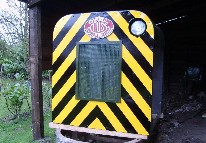
|

|
|
Date: March 2010
|
Date: March 2010
|
Date: May 2010
|
|
The driveway in front of the garage was partly dug up to bed in rails to reach the garage. A sharp 90 degree bend was needed to turn into the edge of the garden.
|
By March the engine cover of No.10 was all finished and was resting on a skip frame waiting to be reunited with the rest of the loco.
|
Finally on the 30th May No.10 rolled down the bridge rail onto the newly laid track in the driveway. This was the first time outside the garage since Sept 2007.
|
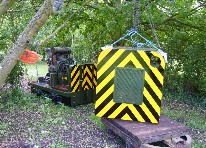
|
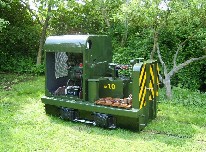
|
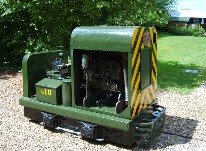
|
|
Date: May 2010
|
Date: May 2010
|
Date: May 2010
|
|
Although the engine cover was not very heavy it was too much for just a couple of people to lift up by hand. Fortunately. an overhanging tree provided a point to secure a winch, and the engine cover was winched up high enough for the loco to to be gently shunted underneath.
|
The finished result, once the engine cover was all bolted down. There was a few minor jobs still to do, including the attachment of the back coupling block, but it finally looks like a decent loco again.
|
Another view on the same day.
|

|
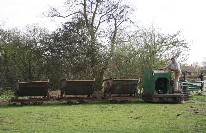
|
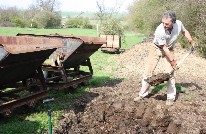
|
|
Date: April 2010
|
Date: April 2010
|
Date: April 2010
|
|
In early April, three medium sized skips were obtained in good condition, originally from Germany, and this was just in time, as they were all pressed into use the next weekend.
|
With No.12 in charge, the three skips were shunted out to the muck heap to start the process of digging out the old manure, now to be excellent compost for the spring.
|
All that was left to do was to fill the skips. In total about 8 skips of manure was dug out over a period of 3 weekends.
|

|
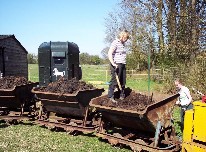
|
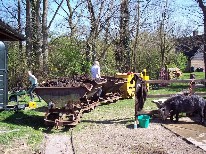
|
|
Date: April 2010
|
Date: April 2010
|
Date: April 2010
|
|
All ready for the return run, with 3 skips loaded up. A bit of sand was required on the rails to get out of the tipping area because of the slight incline and the slippery manure on the tracks.
|
A few days later, there was a steady succession of wheelbarrows as the neighbours filled up with many loads, for hungary gardens coming out of hibernation after a very long winter.
|
The battery loco was in use this time to move the skips in and out of the siding to a convenient point for unloading.
|
January 2010
A harsh winter so far has meant that very little maintenance of the line has been carried out as planned. Most work has focused on the overhaul/restoration of No.10 and it is hoped that the loco will be completed in the next 3 months.

|

|
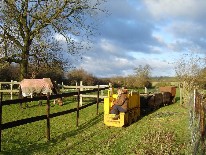
|
|
Date: December 2009
|
Date: December 2009
|
Date: December 2009
|
|
Prolonged snow over December and January gave an opportunity for some seasonal photographs of the railway, although no serious work was attempted.
|
On the same day the W&R loco was photographed moving back into the shed.
|
About a week before the snow came, the W&R is pictured coming back from tipping what is a long train by Springfied standards.
|
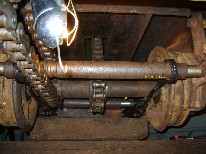
|
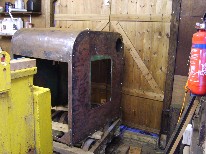
|

|
|
Date: December 2009
|
Date: December 2009
|
Date: January 2010
|
|
Once the wheels were returned for No.10, the brake rods required turning down by a couple of inches on each side. Once these were ready, the wheels, brake gear, and drive chains, were all reassembled while the loco was still jacked up.
|
The engine cover from No.10 was pressed back into shape, and various dents knocked out. A rectangle has been sawn out of the front to add a perforated steel grille, and the whole structure required a lot of attention from the angle grinder and wire wheel to prepare for painting.
|
The current result after 2 coats of primer, 2 layers of undercoat, and the first topcoat, is very slowly taking shape.
|
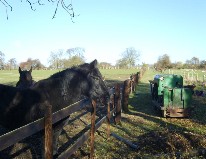
|
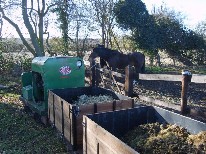
|
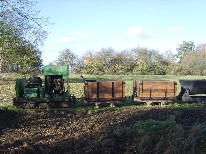
|
|
Date: December 2009
|
Date: December 2009
|
Date: December 2009
|
|
At the start of December the usual muck run was carried out by No.12 seen here coupling up to the last wagon that had been left out for field clearance. Twist is looking on, and takes all this in his stride now.
|
The 2 newly constructed timber open wagons have been very well used and allows the heaver U profile mine tub to be used only as a last resourt.
|
No.12 was pictured leaving the muck pile at the end of the line.
|
October 2009: Summer continues
The continuing dry weather, a contrast to last year, is allowing much more work outside, although a lot of work is now focussed on getting MoŽs No.10 restoration completed.
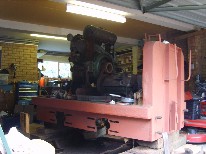
|
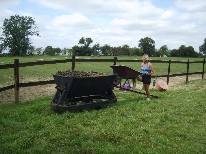
|

|
|
Date: October 2009
|
Date: September 2009
|
Date: September 2009
|
|
MoŽs No.10: Cleaning the layers of grime and Wire brushing the frame, followed by degreasing, has allowed the first coat of primer to be started. Gearbox oil has been cleaned out, new gaskets made, and many smaller fittings either sandblasted or wire brushed with the small angle grinder.Axleboxes, springs, and horn guides all painted and ready for reassembly when the brake hangers have been rewelded to adjust the gauge.
|
As usual in the summer months, most of the wagons are filled out in the fields, and a plank up to the wagon helps this process.
|
About 3 skips are filled this way each week, and so one of the locos are used once or twice per week to then push the wagons to the manure pile for unloading.
|
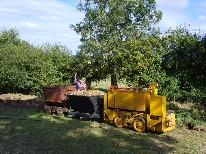
|
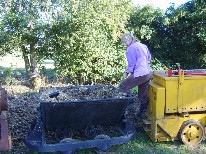
|
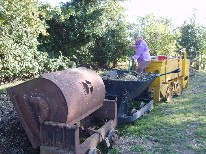
|
|
Date: September 2009
|
Date: September 2009
|
Date: September 2009
|
|
On another occasion, a load of a couple of wagons has been pushed to the manure heap and some manual forking out helps before tipping the wagons.
|
A 4ft jack is always carried on top the loco in case of derailments, but fortunately derailments are quite rare.
|
Although the ex-Force Crag tipping mine tub is a far heaver wagon than the Hudson skip, it has a very easy tipping action with the foot operated catch seen between the wheels in the picture.
|
August 2009: Many smaller jobs going on
No further major tracklaying has been carried out, but stocks of rail and sleepers have been built up so that work can begin once further pointwork is obtained.
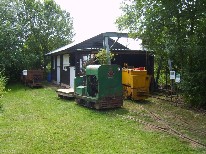
|
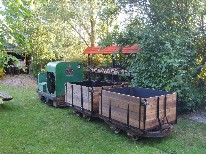
|
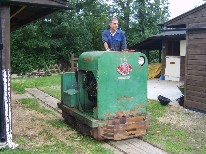
|
|
Date: June 2009
|
Date: August 2009
|
Date: August 2009
|
|
A village 'Open Gardens' event gave the excuse for a big tidy up, and information signs were placed everywhere ready for the visitors and fortunately the weather stayed dry for the event.
|
The second side tipping wagon was completed in July, and both the new wagons are seem here behind MoŽs No.12.
|
On the way past the stables to collect a couple more wagons for emptying
|
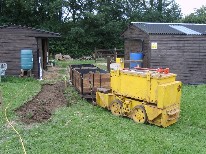
|
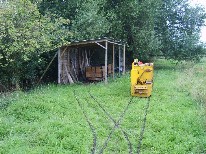
|
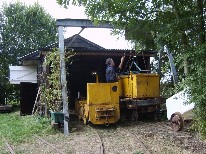
|
|
Date: August 2009
|
Date: August 2009
|
Date: August 2009
|
|
A layer of earth had to be dug out from the stables to the first paddock so hardcore could be laid to provide a better path from the stables. Over wintertime this had a tendancy to become very muddy. The wagons were used to dispose of the waste.
|
A view of the field shelter for some of the stock with the W&R loco coming back to the loco shed.
|
A service is carried out on the W&R loco yearly. Bearing in mind the small amount of use the loco gets here compared with the intensive mines work previously, more frequent attention is probably not required. The battery is hoisted from the loco, to allow access to the wormboxes for topping up oil. All grease points are attended to, and all joints oiled. The cells in the battery box also need topping up which is done 3-4 times per year.
|
Spring 2009: Work in Progress
Work has continued on many fronts this spring, even with the poor weather until recently. This includes work on the track, on the locos, and the rolling stock.
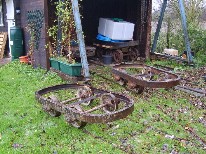
|
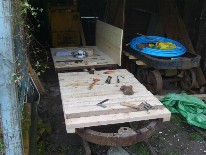
|
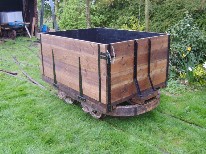
|
|
Date: December 2008
|
Date: February 2009
|
Date: April 2009
|
|
Further skips for use on the railway have been difficult to get hold of. Therefore a couple of skip chassis were purchased via Andrew Neale, with the intention of building a timber side-opening body.
|
After cleaning up, a wooden runner was bolted to the length of the frame, and then a slatted platform, was built on both the frames.
|
The first wagon was completed and in use by April. The strapping and steel angle used was quite lightwieght as these wagons typically will be use for the transport of manure.
|

|
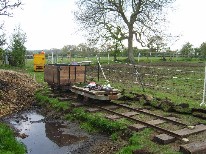
|

|
|
Date: April 2009
|
Date: April 2009
|
Date: May 2009
|
|
The size of the manure pit had grown considerably over the winter with the horses overnighting in the stables. This increases the volume of waste, especially with the use of staw for bedding rather than wood chippings. The rails had only just reached the pit used for disposal, so further tracklaying was required, first along the edge of the pit.
|
Once the sleepers had been dug and levelled as usual, the next set of rails were spiked down. Fortunately as per much of the ground, the footing was quite firm with a hard clay soil, giving support to the sleepers and hopefully preventling any sinking of track.
|
The next couple of panels of rails required an 'S' bend to bring the alignment back to the edge of field, so some hard work was needed with the jimcrow rail bender. By early May this had been completed. A further panel will be laid to allow storage of stock at the end of line when needed just past the tipping point, but that will be as far at operationally needed at present.
|
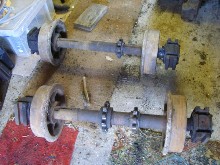
|
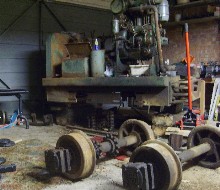
|
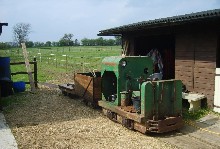
|
|
Date: March 2009
|
Date: March 2009
|
Date: April 2009
|
|
The wheels were finally removed from No.10 by loosening the horn guides, and disconnecting the drive chains, and losening off the brakegear. The loco was jacked right up to allow the wheels to be rolled out from under the loco.
|
After cleaning up, and with the certainty that a significant wheel press would be required to bring in each of the wheels 3 inches on the axle, these wheel sets have been sent of to Alan Keef Ltd for regauging to 2ft. An amount of work is also required on the brake gear to align with the new gauge once the wheels are returned.
|
Fortunately No.12 the other MoŽs loco has continued to perfrom well thoughout the winter and spring. It is seen here outside the stables with the newly constructed side tipping wagon.
|
February 2009: Winter Conditions at Springfield
It was always accepted that there would be short periods where bad weather would prevent operation of the railway. Continual rain over winter causes some parts of the fields to get water logged, and when particularly bad it is left to dry out a little. Not only did we have appauling rain for months on end, but in February we had the worst snow experienced for many years. This lay around for over a week, and the subsequent thaw also then caused further problems with excess water again.
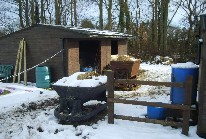
|
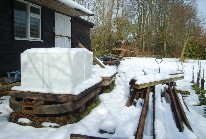
|
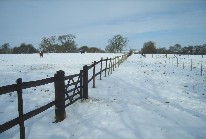
|
|
Date: February 2009
|
Date: February 2009
|
Date: February 2009
|
|
Two of the skips had been marooned by the stables for several weeks, and the waste from the stables was piled up on the hardstanding, and eventually removed with the help of a local farmer.
|
Although the flat wagon with the water tank had been last used only a week before, water had been left in it and it would be days before the water finally thawed out.
|
A view along the field. The tracks follow the line of the fence to the tree line at the end, but with upto 5 inches of snow at one point, no trains were even attempted.
|
© Steve Thomason 2013
Upgraded site relaunched 1st January 2004
| Industrial Narrow Gauge Railways
|

























































































